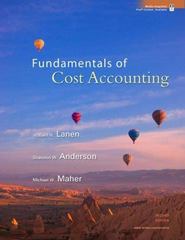Howard Rockness was worried. His company, Rockness Bottling, showed declining profits over the past several years despite
Question:
Howard Rockness was worried. His company, Rockness Bottling, showed declining profits over the past several years despite an increase in revenues. With profits declining and revenues increasing, Rockness knew there must be a problem with costs.
Rockness sent an e-mail to his executive team under the subject heading, "How do we get
Rockness Bottling back on track?" Meeting in Rockness's spacious office, the team began brainstorming solutions to the declining profits problem. Some members of the team wanted to add products. (These were marketing people.) Some wanted to fire the least efficient workers. (These were finance people.) Some wanted to empower the workers. (These people worked in the human resources department.) And some people wanted to install a new computer system. (It should be obvious who these people were.)
Rockness listened patiently. When all participants had made their cases, Rockness said, "We made money when we were a smaller, simpler company. We have grown, added new product lines, and added new products to old product lines. Now we are going downhill. What's wrong with this picture?"
Rockness continued, "Here, look at this report. This is last month's report on the cola bottling line. What do you see here?" He handed copies of the following report to the people assembled in his office.
-1.png)
Rockness asked, "Do you see any problems here? Should we drop any of these products? Should we re-price any of these products?" The room was silent for a moment, and then everybody started talking at once. Nobody could see any problems based on the data in the report, but they all made suggestions to Rockness ranging from "add another cola product" to "cut costs across the board" to "we need a new computer system so that managers can get this information more quickly." A not-so-patient Rockness stopped the discussion abruptly and adjourned the meeting.
He then turned to the quietest person in the room'his son, Rocky'and said, "I am suspicious of these cost data, Rocky. Here we are assigning indirect costs to these products using a 260 percent rate. I really wonder whether that rate is accurate for all products. I want you to dig into the indirect cost data, figure out what drives those costs, and see whether you can give me more accurate cost numbers for these products."
Rocky first learned from production that the process required four activities:
(1) Setting up production runs,
(2) Managing production runs, and
(3) Managing products. The fourth activity did not require labor; it was simply the operation of machinery. Next, he went to the accounting records to get a breakdown of indirect costs. Here is what he found:
-2.png)
Then, he began a series of interviews with department heads to see how to assign these costs to cost pools. He found that 40 percent of indirect labor was for scheduling or for handling production runs, including purchasing, preparing the production run, releasing materials for the production run, and performing a first-time inspection of the run. Another 50 percent of indirect labor was used to set up machinery to produce a particular product. The remaining 10 percent of indirect labor was spent maintaining records for each of the four products, monitoring the supply of raw materials required for each product, and improving the production processes for each product. This 10 percent of indirect labor was assigned to the cost driver "number of products."
Interviews with people in the information technology department indicated that $10,000 was allocated to the cola bottling line. Eighty percent of this $10,000 information technology cost was for scheduling production runs. Twenty percent of the cost was for recordkeeping for each of the four products.
Fringe benefits were 40 percent of labor costs. The rest of the overhead was used to supply machine capacity of 10,000 hours of productive time.
Rocky then found the following cost driver volumes from interviews with production personnel.
• Setups: 560 labor-hours for setups.
• Production runs: 110 production runs.
• Number of products: 4 products.
• Machine-hour capacity: 10,000 hours.
Diet cola used 200 setup hours, 40 production runs, and 5,000 machine-hours to produce 50,000 units. Regular cola used 60 setup hours, 30 production runs, and 4,000 machine-hours to produce 40,000 units. Cherry cola used 240 setup hours, 30 production runs, and 900 machine hours to produce 9,000 units. Grape cola used 60 setup hours, 10 production runs, and 100 machine-hours to produce 1,000 units. Rocky learned that the production people had a difficult time getting the taste just right for the Cherry and Grape colas, so these products required more time per setup than either the Diet or Regular colas.
Required
a. Compute cost driver rates for each of the four cost drivers.
b. Compute unit costs for each of the cola products: Diet, Regular, Cherry, and Grape.
c. Prepare a new "Monthly Report on Cola Bottling Line," but with your revised indirect cost numbers for each product.
d. Prepare a memorandum to Howard Rockness recommending what todo.
Step by Step Answer:

Fundamentals Of Cost Accounting
ISBN: 0071332618
2nd Edition
Authors: William Lanen, Shannon Anderson





